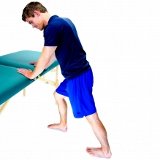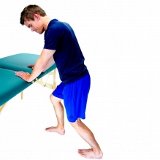Understanding Plantar Fasciitis
4/7/2015
By: Erin Ziprick, RMT  As the summer months come closer and the temperature warms up, people are generally more eager to get outside and start their summer activities. Along with those activities common overuse injuries may come up if the person isn't prepared or educated. One of the most common causes of foot pain in athletes is plantar fasciitis. Plantar fasciitis is an overuse condition resulting in inflammation of the plantar fascia. (Rattray) It can result in tissue fatigue and micro tearing at the calcaneal (heel) attachment. “The plantar fascia is a thick, fibrous band of connective tissue. Its origin is the medial plantar tubercle of the calcaneum. It runs along the sole of the foot like a fan, being attached at its other end to the base of each of the toes. It is a tough, resilient structure that has a number of critical functions during running and walking: * It stabilizes the metatarsal joints during impact with the ground. * It acts as a shock absorber for the entire leg. * It forms the longitudinal arch of the foot and helps to lift the arch to prepare it for the 'take-off' phase of the gait cycle.” Research shows that plantar fasciitis “may account for as much as 8% of all running-related injuries [3 4]. The life time prevalence may be as high as 10% which means that quite a big proportion of us will at some point be affected by plantar fasciitis or see these patients in the clinic.” Treatment: One of the best ways to start treatment for planar fasciitis is to cease from the activity that is causing the pain, albeit running, jogging, cycling, climbing, or aerobics. Footwear should be such that gives more support even though it may be stiffer. Arch supports, orthotics, can also help reduce the pain, and it is said that stretching the calf muscles also affords some relief. Icing the area for about 15 minutes every day can also help. Once initial recovery is made, patients should consider a more aggressive form of treatment such as deep tissue massage. Deep tissue massage is applied by using deep finger pressure on the fascia, Achilles heel, and calf muscles through slow strokes. The muscle fibers can be followed or pressure can be applied across tendons. Deep tissue massage can help to release the muscle tension, break scar tissue, and lead to its elimination. The massage therapist will concentrate on specific areas, and it is likely that the patient may feel some soreness before and after the massage.  Stretches: STANDING CALF STRETCH - GASTROCNEMIUS While standing and leaning against a wall, place one foot back behind you and bend the front knee until a gentle stretch is felt on the back of the lower leg. Your back knee should be straight the entire time.  STANDING CALF STRETCH - SOLEUS While standing and leaning against a wall, place one foot back behind you and bend the front knee until a gentle stretch is felt on the back of the lower leg. Your back knee should be bent the entire time. Hold each stretch for 15-30 seconds and you can perform this throughout the day.  Hydrotherapy: Another effective way to help decrease inflammation of the plantar fascia is to apply hydrotherapy. FREEZE A PLASTIC WATER BOTTLE: Taking the frozen water bottle out of the freezer and begin to roll the bottle on the bottom of your foot. The ice in the bottle will help decrease inflammation of the foot and providing relief. Be careful to not over-ice the injury to avoid any tissue damage. Perform this no more then 15 minutes at a time. With appropriate rest and a combination of both remedial exercise and massage therapy, you will be back on your feet. For more information on a treatment plan, consult your massage therapist or local chiropractic clinic. References: * http://www.patient.co.uk/doctor/plantar-fasciitis - (03/15/15) * http://blogs.bmj.com/bjsm/2014/09/15/plantar-fasciitis-important-new-research-by-michael-rathleff/ - (03/15/15) * Rattray, Fiona. (March 2000). Clinical Massage Therapy. Elora, Ontario: Talus Incorporated.
17 Comments
Preparing your Body for Winter Activities
11/25/2014
By: Erin Ziprick, RMT  As the snow starts to fall and the temperature falls below zero, it is important to remind ourselves to keep active and continue to live a healthy lifestyle throughout the cold winter months. It seems easy enough to head inside, curl up on the couch with a warm cup of hot chocolate and a blanket and hibernate for the rest of winter. Let’s embrace the cold and head outside to enjoy those special activities only the winter can bring. This alone brings a unique list of challenges and obstacles to staying injury free especially when you are introducing winter specific activities that you haven’t performed for over six months. Before the cold winter months, you can take steps towards loosening up your muscles and keeping healthy so that once you hit the slopes or strap on your rusty ice skates with your family, you minimize the after-activity soreness and to decrease muscle fatigue. It is very important to keep a regular stretching routine as well as regular massage therapy sessions to have an active and injury free winter season. The key to having an injury free season is to focus on the body’s flexibility and lengthening of your muscles. You can be successful with this prior to the winter’s months. Some popular winter season activities are snowboarding, skiing, and ice-skating and these activities physically impact your lower body. Therefore focusing on strengthening and lengthening your hamstrings, hips, lower back and core will increase your overall flexibility and prevent injury. According to American College of Sports Medicine, Whether you choose to perform static stretches (by holding each position for 10-30 seconds) or perform dynamic stretches (by moving the body through a functional range of motion) flexibility prepares the muscles, tendons and joints for work by allowing them to move freely through a full active range of motion. The more prepared the body is, the less likely it is to get injured. Before you perform the activity, a warm up is beneficial to your body as it helps increase circulation and to reduce muscle tightness letting you to perform at you is best. To kick off the winter season it is important to combines consistent stretching with regular therapeutic massage sessions. Regular massage therapy sessions allow your body to release toxins found in tight muscles, improve flexibility, increase joint mobility, and improve circulation. Your massage therapist can help you in achieving your goals with additional stretches and exercises that will help improve your flexibility and keep you injury free. Whether you are preparing your body for family fun winter activities or recovering from a wither sport injury or accident, therapeutic massage treatments combined with regular stretching regimens should be your go-to strategy for minimizing aches and pains this winter season. References http://www.acsm.org/access-public-information/articles/2012/01/10/basic-injury-prevention-concepts http://www.rmtao.com/Massage_Therapy/the_benefits_of_mt/massage_therapy_helps.htm |
AuthorPosts inspired by the team at Platinum Health & Wellness. Archives
June 2025
Categories
All
|
|
 RSS Feed
RSS Feed